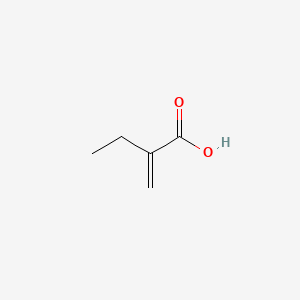| MeSH term | MeSH ID | Detail |
|---|---|---|
| Carcinoma, Basal Cell | D002280 | 6 associated lipids |
| Arrhythmias, Cardiac | D001145 | 42 associated lipids |
| Adenocarcinoma | D000230 | 166 associated lipids |
| Dermatitis, Contact | D003877 | 59 associated lipids |
| Dermatitis, Occupational | D009783 | 12 associated lipids |
| Lung Neoplasms | D008175 | 171 associated lipids |
| Body Weight | D001835 | 333 associated lipids |
| Edema | D004487 | 152 associated lipids |
| Bone Resorption | D001862 | 7 associated lipids |
| Brain Injuries | D001930 | 4 associated lipids |
2-Ethylacrylic acid
2-Ethylacrylic acid is a lipid of Fatty Acyls (FA) class. The involved functions are known as hemolysis.
Cross Reference
Introduction
To understand associated biological information of 2-Ethylacrylic acid, we collected biological information of abnormalities, associated pathways, cellular/molecular locations, biological functions, related genes/proteins, lipids and common seen animal/experimental models with organized paragraphs from literatures.
What diseases are associated with 2-Ethylacrylic acid?
There are no associated biomedical information in the current reference collection.
Possible diseases from mapped MeSH terms on references
We collected disease MeSH terms mapped to the references associated with 2-Ethylacrylic acid
PubChem Associated disorders and diseases
What pathways are associated with 2-Ethylacrylic acid
There are no associated biomedical information in the current reference collection.
PubChem Biomolecular Interactions and Pathways
Link to PubChem Biomolecular Interactions and PathwaysWhat cellular locations are associated with 2-Ethylacrylic acid?
There are no associated biomedical information in the current reference collection.
What functions are associated with 2-Ethylacrylic acid?
Related references are published most in these journals:
| Function | Cross reference | Weighted score | Related literatures |
|---|
What lipids are associated with 2-Ethylacrylic acid?
There are no associated biomedical information in the current reference collection.
What genes are associated with 2-Ethylacrylic acid?
There are no associated biomedical information in the current reference collection.
What common seen animal models are associated with 2-Ethylacrylic acid?
There are no associated biomedical information in the current reference collection.
NCBI Entrez Crosslinks
All references with 2-Ethylacrylic acid
Download all related citations| Authors | Title | Published | Journal | PubMed Link |
|---|---|---|---|---|
| Kameyama A et al. | Influence of different acid conditioners on the tensile bond strength of 4-META/MMA-TBB resin to Er:YAG laser-irradiated bovine dentin. | 2000 | J Adhes Dent | pmid:11317376 |
| Szara WL | Increase profits and save time creating the perfect provisional restorations. | 2000 | J Dent Technol | pmid:11323845 |
| Kamal AM et al. | Response of Class II molecule-expressing cells and macrophages to cavity preparation and restoration with 4-META/MMA-TBB resin. | 2000 | Int Endod J | pmid:11307213 |
| Beruto DT et al. | Use of alpha-tricalcium phosphate (TCP) as powders and as an aqueous dispersion to modify processing, microstructure, and mechanical properties of polymethylmethacrylate (PMMA) bone cements and to produce bone-substitute compounds. | 2000 | J. Biomed. Mater. Res. | pmid:10602083 |
| Bacskulin A et al. | New osmotically active hydrogel expander for enlargement of the contracted anophthalmic socket. | 2000 | Graefes Arch. Clin. Exp. Ophthalmol. | pmid:10664048 |
| Sterker I et al. | [Clinical anophthalmos. Cosmetic outcome after 2 years therapy with an orbital expander for stimulating orbital growth]. | 2000 | Klin Monbl Augenheilkd | pmid:10820704 |
| D'Urso PS et al. | Custom cranioplasty using stereolithography and acrylic. | 2000 | Br J Plast Surg | pmid:10738323 |
| Cooper ME and Mess D | Isolated skeletal metastasis to the patella. | 2000 | Am J. Orthop. | pmid:10746472 |
| Lin CT et al. | Degradation of repaired denture base materials in simulated oral fluid. | 2000 | J Oral Rehabil | pmid:10784330 |
| Hasirci V et al. | High strength bioresorbable bone plates: preparation, mechanical properties and in vitro analysis. | 2000 | Biomed Mater Eng | pmid:10950204 |
| Wood ML et al. | Open reduction and cementation for femoral head fracture secondary to avascular necrosis: preliminary report. | 2000 | Iowa Orthop J | pmid:10934620 |
| Shore PA et al. | A three-dimensional histological method for direct determination of the number of trabecular termini in cancellous bone. | 2000 | Biotech Histochem | pmid:10999569 |
| Sakai T et al. | Prevention of fibrous layer formation between bone and adhesive bone cement: in vivo evaluation of bone impregnation with 4-META/MMA-TBB cement. | 2000 | J. Biomed. Mater. Res. | pmid:10906671 |
| Sakai T et al. | In vivo evaluation of the bond strength of adhesive 4-META/MMA-TBB bone cement under weight-bearing conditions. | 2000 | J. Biomed. Mater. Res. | pmid:10906683 |
| Bär FW et al. | New biocompatible polymer surface coating for stents results in a low neointimal response. | 2000 | J. Biomed. Mater. Res. | pmid:10906692 |
| Leclair A et al. | Rapid chondrolysis after an intra-articular leak of bone cement in treatment of a benign acetabular subchondral cyst: an unusual complication of percutaneous injection of acrylic cement. | 2000 | Skeletal Radiol. | pmid:10883447 |
| Oleksik A et al. | Bone structure in patients with low bone mineral density with or without vertebral fractures. | 2000 | J. Bone Miner. Res. | pmid:10893686 |
| Sharif N et al. | The chemical stain removal properties of 'whitening' toothpaste products: studies in vitro. | 2000 | Br Dent J | pmid:10893817 |
| Ferrero C et al. | Fronts movement as a useful tool for hydrophilic matrix release mechanism elucidation. | 2000 | Int J Pharm | pmid:10915923 |
| Fujisawa S et al. | Cytotoxicity of methyl methacrylate (MMA) and related compounds and their interaction with dipalmitoylphosphatidylcholine (DPPC) liposomes as a model for biomembranes. | 2000 | Oral Dis | pmid:10918558 |
